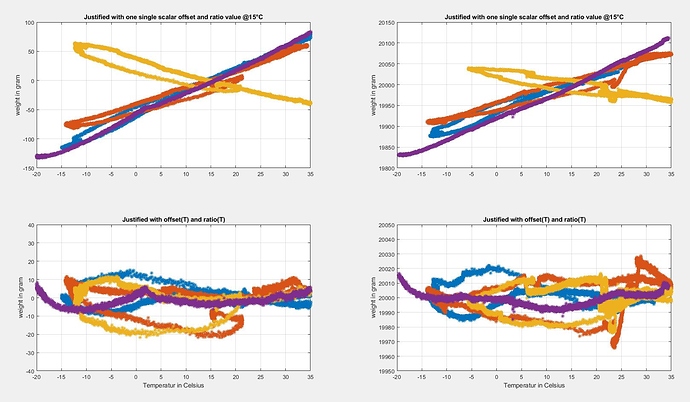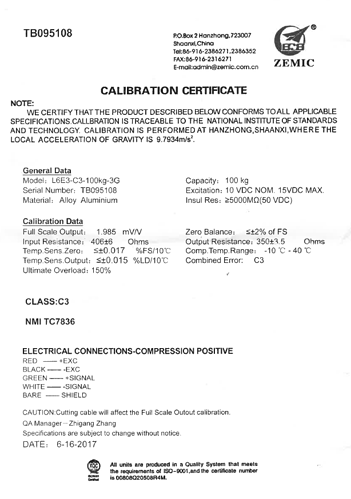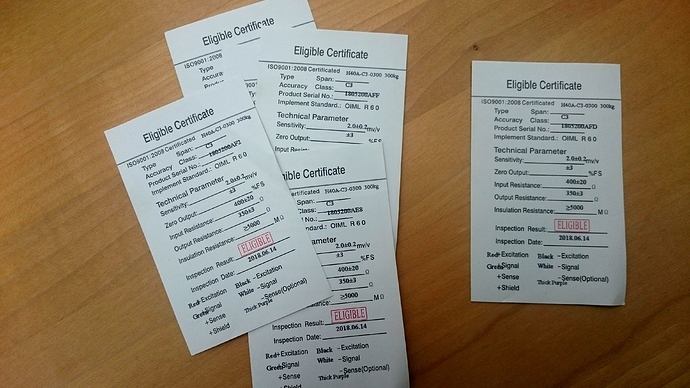What are the 4 scales / cells / setups?
HX711 and Bosche H40A.
Sorry to bother you again, @zmaier. ;-) You have in the first graph 4 lines, purple, yellow, orange and blue, this are the same setups? All with a HX711 and a Bosche H40?? So why has the purple one nearly no temperature effect and the yellow one such a big? I fear I do not understand the difference of the 4 “settings”. May you clarify this, thanks!
Is the only difference that you are using different load cells (but all H40 from Bosche with the same max. weight?).
The 4 lines are 4 setups each with a HX711 and a H40A-100kg.
Why setup 4 is good, all others not, i don’t know.
I have no clue.
Can you imagine what was special / other on the purple setup? Other power source, flux cleaned vs. not cleaned? screw terminals vs. cable soldered? Cut / shorted cable? Really no difference??! The purple setup is great. So in case we can find “the error” – and it is not inside the Bosche H40 this would be great! ;-) Many thanks again for the effort and time you spent!
I have absolutely no idea.
I started the thread below, because i have seen those huge differences between the setups.
To figure out why, “built” the test-chamber.
All setups have the same build-up.
Flux is cleaned
HX 711 and Load Cell is soldered with the original cable (not shortend)
Power-Supply is the same
I have no idea why?
It seems the Load Cells are really that “weak”, see my posting where I compared the temperature behavior just of the cell and just the HX711. It clearly comes from the cell itself.
What are your experiences? Should i contact Bosche with this issue?
Hi…humidity effects are rather slow and require the humidity to penetrate the epoxy that bonds the resistors to the base lever. Even the slight effect of the humidity swelling or weakening the epoxy are going to be very slight vs the temperature. Measure over several days, I doubt there is a correlation to humidity.
Is number 4 the only sensor connected with the gray/white cable in your picture in the very first post here? Is it somehow different to the others? e.g. shielding, diameter, material, twisted-or-not?
hi, what do you mean with gray/white cable, where have you seen it?
all setups are identically, no difference in cables, diameter, shielding,…
I asked Bosche three weeks ago and also last week but still no answer. I am disappointed, though buying a german product whould give me a better support. I try “Aliexpress load cells” next, cost one third.
Sorry, I just took a rough look at the image in this post and wondered to see four cables joining in a box and one of these seems different.
So the anyhow-general-underlying question is: Does something differ within the cable, taking furher distance and magnetic-fields in mind. But it’s just meant as a simple “did you check that”- queston.
Some days ago I read a FB posting about a 4 cell setup with poor reading results. They could solve the problem by a proper grounding. Did you connect the shield of the cable to ground Just brainstorming.
Yes, the shield is connected to GND.
Noch immer keine Antwort von BOSCHE, mittlerweile die dritte freundliche EMail veschickt.
Ich bin kein Großkunde, aber dennoch hätte ich mir eine Antwort erwartet.
Ich bin auf der Suche nach ähnlichen Zellen für meine weiteren Waagen, Bosche möchte ich mir nicht mehr kaufen.
Wer hat Alternativen, wenn möglich aus Europa?
Es gibt Neukigkeiten.
Ich hatte gestern ein Telefonat mit Bosche.
Dort wurde mir erklärt, die 3 Wägezellen sind nicht normal, sondern stammen aus einer anderen Charge.
Normalerweise werden die Zellen vermessen und in Genauigkeitsklassen kategorisiert.
Bei meiner Bestellung wurden die falsche Klasse ausgeliefert. Neben den auf der Homepage angebotenen Zellen gäbe es auch noch die Möglichkeit diese “nicht guten” zu kaufen. Preislich sind diese aber nur ein paar € billiger.
Mir wurde ein Austausch angeboten, ich weiß aber noch nicht ob ich mir das antun soll, der Umbau kostet Zeit - die ich nicht habe :) Weiters habe ich gefragt ob der Temperaturgang reproduzierbar ist, was eindeutig mit ja beantwortet wurde. Somit kann ich mit der individuellen Kompensation gut leben denk ich.
Wägezelle #4 stellt den Regelfall da (wenn bei der Lieferung nichts schief geht).
Einem Unternehmen welches IS0 9001 zertifiziert ist und somit einen Prozess zur Qualitätssicherung haben muss, darf sowas eigentlich nicht passieren.
Tja, ich habe dennoch 4 weitere Zellen dort bestellt, es wurde mir versichert diese werden handverlesen noch einmal überprüft. Ich werde diese aber in meiner “Klimakammer” überprüfen.
Das ist ja eine interessante Aussage, Danke für die Info! Bei den Preisen bei Bosche wundert es mich, dass sie für ein paar EUR weinger dann doch deutlich schlechtere Zellen anbieten.
Wenn #4 der Normalfall wäre, wäre das natürlich klasse! q.e.d. ;-)
Ich habe 4 weitere Zellen bei Bosche bestellt (wieder - H40A 100 kg). Laut Bosche wurden die Zellen handverlesen und in deren Klimakammer überprüft.
Hier das Ergebnis:
links unbelastet, rechts 20kg
oben Rohwerte ohne Temperaturkompensation
unten Temperaturkompensiert
Interessant, die gelbe Zelle hat einen negativen Temp-Koeffizienten, die anderen einen positiven.
Sehr interessant, die Wägezelle 4 ganz oben (violett im Diagramm) von der ersten Bestellung war ja “perfekt” und schwankte über den kompletten Temperaturbereich fast nicht. Die neu bestellten, von Bosche extra ausgemessenen und getesteten, haben einen deutlich breiteren Streubereich – mit ähnlicher Schwankung wie die restlichen drei aus der ersten Bestellung. Alle zwar durch die stabile Linearität gut kompensierbar aber man müsste das halt mit individuellen Koeffizienten machen, wenn man hier verbessern will.
Ja komisch. Ich habe extra für jede Zelle einen Prüfbericht mitbekommen. Dort steht die Zelle entspricht den C3 Standards.
Ich kann zwar mit Temp.Sens Zero und Temp Sens Output nichts anfangen, aber wird schon alles stimmen 
Interessant wäre, wie sieht der Tempgang von “billigen” China-Nachbauten aus? (wobei die ja auch aus China kommt?!)
Wissen wir welche BOSCHE Wägezellen in unseren Systemen verbaut sind?
@Diren
Habt ihr die Messzertifikate bei euch? Können wir da was nachvollziehen, welche Zelle welchem Zertifikat zuzuordnen ist? (Seriennummer)


